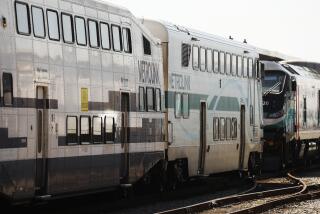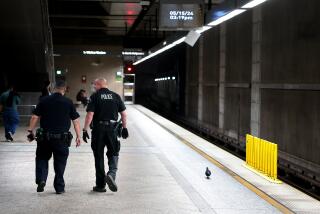Metrolink needs top-to-bottom improvements, report says
Top-to-bottom improvements in the safety culture of the Metrolink rail system are needed to reduce the odds of future accidents like the September disaster in Chatsworth that killed 25 people and injured 135 others, a panel of experts said Friday.
A two-month review of the five-county commuter train operation found that a far greater focus on safety was needed, starting with oversight of the contract employees at the controls of locomotives and extending to involvement of agency board members in ensuring that safety policies are enforced.
Although the report was implicitly a criticism of current management practices, David R. Solow, the agency’s executive director, declined to react to the list of recommendations, other than to tell The Times, “That’s what I’m going to do.”
The critique took aim at all levels of the organization; board member Richard Katz, who pushed for the study, said it offered an opportunity for Metrolink to move ahead in a rail industry often criticized for moving too slowly on passenger safety improvements.
“We want to move from trailing the pack to leading the pack when it comes to safety,” Katz said.
The Sept. 12 catastrophe, the worst train accident in modern California history, helped focus national attention on passenger rail safety and prompted landmark changes in federal law. After years of delay, Metrolink and other rail systems have been ordered to install high-tech, automated train control systems that can compensate for the kinds of human error suspected in the Chatsworth collision.
The engineer operating the Metrolink train had been text messaging with a cellphone and ran a red light seconds before slamming head-on into a Union Pacific freight train, according to the preliminary findings of federal safety investigators. Some witnesses say the light did not appear to be red.
The so-called Peer Review Panel report presented to Metrolink board members Friday was the work of industry and private-sector experts, part of an agency campaign to restore confidence in the 16-year-old rail network, which carries about 48,000 passengers each weekday and has had one of the deadliest records in the nation in recent years.
Key among the findings is that Metrolink needs to step up its monitoring of all “safety critical” workers, chiefly engineers and conductors. In addition to more frequent testing and live video monitoring of train crews, the agency needs to overhaul an antiquated record system that prevents it from rapidly identifying problems with workers and equipment in the field.
Pending federal requirements, which have been postponed at the request of the rail industry, will mandate that the agency develop an ability to monitor daily safety operations using new computer technology, the panel noted.
Metrolink needs to move rapidly to deploy such a system, said panel member and rail executive Bill Parsons, noting that agency workers track employee performance with outdated, cumbersome paperwork.
Meeting new safety requirements, he said, is “going to be near impossible with the present system you have.”
Other recommendations range from restructuring the management of the agency to appointing a top executive charged with overseeing safety. The report also called for a first-ever effort to train appointed board members, many of them council members from small cities, and clearly define their duties regarding safety issues.
Board chairman Ron Roberts, from Riverside County, said the latter proposal was long overdue. “You hit the nail on the head,” he said. “I don’t think I’ve ever seen anything like that.”
Additional details of the panel’s findings and estimates of the cost of implementing the ambitious list of reforms are to be fleshed out in reports to the board next month.
Los Angeles County Supervisor Michael Antonovich, a board member, seized on one issue raised by the panel: the possible annual medical testing and periodic psychiatric examinations of engineers and other employees in critical positions.
“We have the ability to take that action immediately,” he said, referring to the agency’s contract with Connex Railroad, which provides train crews. Connex’s parent company is Veolia Transportation. “Our first responsibility has to be the safety of customers who ride the rail.” If the contractor balks at such testing, “we have to find another [company] . . . or shut down the operation.”
Metrolink has changed several operating practices since the Chatsworth crash, including putting an extra crew member in the train cab and revising procedures for confirming trackside warning signals.
The agency also added a speed regulation after a Metrolink train accelerated to nearly 70 mph before sideswiping a freight carrier in Rialto last month, injuring five people. That Metrolink train also ran a red light, investigators said.
Experts have criticized the commuter line for not moving to overhaul safety practices sooner.
“This is not rocket science,” said Barry M. Sweedler, who spent 30 years as an investigator and administrator with the National Transportation Safety Board, which is leading the Chatsworth investigation.
“All the right things are being said,” he said of the report and the board’s reaction. “The question is: Will they follow through?”
Connell and Lopez are Times staff writers.
More to Read
Sign up for Essential California
The most important California stories and recommendations in your inbox every morning.
You may occasionally receive promotional content from the Los Angeles Times.











